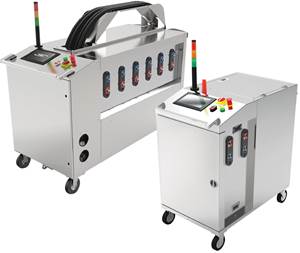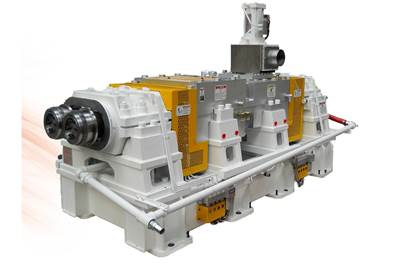Open Automation Enables Flexibility in Chemical Recycling
Software-defined equipment control systems can be duplicated, transferred and scaled with ease.
Industrial-scale mechanical recycling operations for PET bottles are well established, but the chemical structure of PET offers multiple pathways for recycling that could utilize other available feedstocks, such as polyester textiles. GR3N is the developer of one such pathway: the microwave-assisted depolymerization (MADE) solution for recycling PET. The process is based on alkaline hydrolysis and produces mono-ethylene glycol (MEG) and terephthalic acid (TPA).
In March 2024, GR3N inaugurated its demonstration facility in Albese con Cassano, Italy. GR3N will test the necessary technology in preparation for its next scale-up, to an industrial facility in Spain. This technological demonstration includes the controls system, for which GR3N has collaborated with Schneider Electric.

GR3N’s chemical recycling system uses microwaves to facilitate the depolymerization of PET. Source: GR3N
Schneider’s Ecostruxure Automation Expert provides an automation platform for integrating process controls, and implements the concept of open automation based on the architecture defined in the IEC 61499 standard. The standard is aimed at facilitating a move away from proprietary control systems, thus reducing vendor lock-in, and providing for interoperability and flexibility.
Opening Up Production Automation
Many production facilities are composed of processes that are interrelated and interdependent, but isolated at the information level. In contrast to the way software works in information technology, control software on programmable logic controllers (PLCs) is often vendor-specific, proprietary and incompatible with systems created in different development environments. This complicates attempts to integrate systems across equipment from various vendors and to implement the kind of connections with IT systems that enable the benefits of Industry 4.0.
With the open automation approach, each piece of equipment is designed to be interoperable with the whole operation, even if it includes a variety of equipment from different vendors. UniversalAutomation.org, a nonprofit established in 2021, provides a shared source run time execution engine to equipment suppliers, and they use it to develop the controls for their equipment.
“Software-defined automation does not necessarily need the third-party automation suppliers to change their product. It can still be used as an orchestration layer that links to IT tools,” explains Delphine Largeteau, global sustainability consulting director for energies and chemicals at Schneider. “However, to take advantage of the full interoperability and portability of the control strategy, then they must implement the control runtime engine provided by universal automation.org.”
Not all equipment suppliers have embraced the concept, but Universal Automation has grown from its initial membership of nine, including GR3N and Schneider, to over 100.
“We are also an equipment vendor, but we decided that vendor lock-in was not the right place to be. So we decided to take the leap, and we hope others will too,” Largeteau says.
Decoupling the controls from the equipment hardware makes it easier to change or upgrade individual pieces of equipment, without having to replace everything at once or remain tied to a specific vendor. In addition to decoupling life cycles for more efficient upgrades, this flexibility can also reduce the risk to an operation from supply chain disruptions such as those caused by the Coronavirus pandemic. It also benefits a startup that is trying to move through technological development stages quickly.
Recycling Operations Benefit From Decoupling Software and Hardware
GR3N was seeking a product that would enable it to replicate what the company had built and scale up easily. The industrial operation is expected to have a capacity of 40,000 tons per year, which will require running reactors in parallel. Because the automation system is object oriented, replicating an object at a larger scale, or adding additional objects/reactors, for example, will simply be a matter of cut and paste. It is expected the company will save 30% in engineering costs.
According to Fabio Silvestri, head of marketing and business development at GR3N, software-defined automation and hardware independence has enabled the company to de-risk its operations, reconfigure systems quickly to improve efficiency and avoid supply chain issues while it pushes the boundaries of the MADE technology.

Interconnected subsystems represented by objects in Ecostruxure Automation Expert. Source: Schneider Electric
GR3N’s industrial scale facility is expected to be operational in 2027, and will include pretreatment, depolymerization and repolymerization operations. GR3N plans to license the process to other producers in the future, which will also be facilitated by the flexible and portable controls scheme.
Related Content
New Technology Enables ‘Smart Drying’ Based on Resin Moisture
The ‘DryerGenie’ marries drying technology and input moisture measurement with a goal to putting an end to drying based on time.
Read MoreAI: The Next Big Thing in Plastics Processing
Discover how artifical intelligence is revolutionizing plastics processing. Hear from industry experts on the future impact of AI on your operations and envision a fully interconnected plant.
Read MoreSystem Offers 'Lights Out' Mold-Channel Cleaning & Diagnostics
New system automatically cleans mold-cooling lines—including conformal channels—removing rust and calcium, among other deposits, while simultaneously testing for leaks, measuring flow rate and applying rust inhibitor.
Read More'Smart,' Moisture-Based Drying Technology Enhanced
At NPE2024, Novatec relaunches DryerGenie with a goal to putting an end to drying based on time.
Read MoreRead Next
Continuous Mixer Supports Mechanical and Chemical Recycling Applications
NPE2024: Recycling solution works for a variety of situations including pyrolysis.
Read MoreWhere Do You Fall On Industry 4.0’s Adoption Curve?
Beyond the hype: how are injection molders applying industry 4.0 today, and what’s coming in the future.
Read More




















